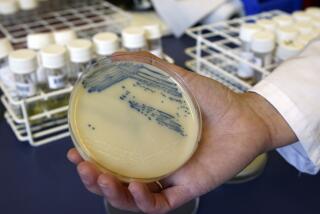Scripps Scientists Speed Up Evolution : Genetics: Researchers compress 10 million years into 10 days in a process that could eventually help fight viruses such as AIDS.
- Share via
Scripps Research Institute scientists have developed a process that compresses 10 million years of molecular evolution into 10 days--a discovery that offers insights into evolution as well as a new tool for genetically engineered drugs.
“This is closer to evolution than what anyone has done before,” said Leslie Orgel, a chemist with the Salk Institute.
Scripps scientists directed the evolution of a molecule in a test tube, according to today’s issue of Science. The method might be used someday to tailor specific molecules that could be used to help battle viral diseases, such as AIDS, the researchers said.
“There are plenty of enzymes in nature that have evolved. Now it’s happening not in nature, but on our bench,” said Gerald Joyce, an assistant professor of chemistry and molecular biology at Scripps Research Institute. “It’s just mimicking the process of Darwinian evolution and speeding it up to a large population of molecules.”
For the research, Joyce and Scripps research technician Amber Beaudry started with one population of enzymes, those that cleave RNA, and forced them to evolve in 10 generations into a different enzyme, those that cleave DNA.
“To me, it’s not all that different from breeding chickens,” Joyce said. “It’s just like breeding anything--cats or roses. Ultimately, you end up with a chicken that lays big eggs.”
Some scientists called the discovery a crucial step in the advancement of biotechnology.
“It’s really important. It’s the first time these new evolution methods have been used to change what an enzyme does,” said Jack Szostak, professor of genetics at Harvard Medical School.
“Gerry is the first person to have controlled Darwinian selection,” Orgel said. Scientists believe that living organisms spring from three basic chemical building blocks: deoxyribonucleic acid (DNA), ribonucleic acid (RNA) and proteins. DNA, which holds genetic information, serves as a blueprint of life. RNA serves as the messenger that takes these blueprints and reads them to the protein-making machinery.
Scientists recently discovered that RNA is versatile--it can hold genetic information as well as serve as a messenger. Because of that discovery, Joyce said, he chose to work with RNA rather than its more complicated counterpart, DNA.
Joyce and Beaudry began their study with a population of 10 trillion molecules. They chose a particular group of molecules that usually cleave RNA, and also have a limited ability to cut strands of DNA under high temperatures.
Through a series of tests, the researchers pinpointed any molecules that cleaved DNA and gave them chemical markers.
The marked molecules were allowed to reproduce. With each generation, new mutations evolved. Some, for instance, would more aggressively cut at strands of DNA. Beaudry and Joyce kept selecting those for reproduction.
After 10 generations, the researchers ended up with molecules that were 100 times more efficient at cleaving DNA, Joyce said. The molecules could carry out the activity under normal cell-like conditions and did not require high temperatures.
“All we were doing is following Darwin’s recipe at the level of molecules,” Joyce said.
A molecule’s ability to snip strands of DNA is a useful one because, in doing so, the molecule stops the cell’s ability to reproduce. With AIDS and other viral diseases, such a feat could cripple the disease’s ability to spread.
For studies that have not yet been published, Joyce said he experimented with the newly evolved DNA-snipping molecules to see whether they could cleave the DNA of a well-known laboratory virus called M-13.
The newly evolved molecule did, indeed, prevent the spread of the virus. But Joyce views these preliminary results with caution.
“Vaccinating against M-13 is one thing and vaccinating a human cell against a retro-virus (the type of virus that causes AIDS) is a whole different kettle of fish,” Joyce said. “This is a strategy for attack.”
In addition to the possible medical applications, scientists say Joyce’s work opens a window to the process of evolution.
“You can do experiments with fruit flies. You can do very few experiments with higher organisms,” said Larry Simpson, an investigator with UCLA’s Howard Hughes Institute. “To study evolution in a test tube is to allow you to test various models. It’s a very elegant idea.”






